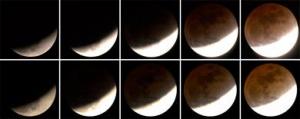New tool that simulates past and future eclipses
The lunar eclipse has been thoroughly documented throughout human history. This rare and breathtaking phenomenon appears when the Moon enters the darkness of the Earth and seems to change its shape, color, or disappear completely from the night sky. This phenomenon attracted the attention of all mankind, from poets, farmers, leaders, to scientists.
Researchers at Rensselaer Polytechnic Research Institute have developed a new method of using computer graphics to describe and create accurate images of eclipses. This model uses geometric data of the sun, Earth, moon, and data on the Earth's atmosphere and the optical properties of the moon to create a complete illustration good about eclipse.
Computer-generated images are exactly the same as actual lunar eclipse images, which allow people to look back at famous historical eclipse events or preview eclipse images that will happening in the near future according to forecast. The model can also be adjusted to produce images when observing the lunar eclipse from different positions on Earth - the lunar eclipse will bring different images at the same time, depending on whether the viewer is in New York, Seattle, or Rome.
'Other researchers have also created works that simulate the night sky, the moon, the sky at sunset, but this is the first success in building a lunar model,' Barbara Cutler, science lecturer. computers at Rensselaer, who participated in the study, said. 'Our model can help survey atmospheric phenomena in history, and it is also beneficial for artists who intend to add this special effect to their toolbox.'

The top row is digital photos from Troy, New York, about the lunar eclipse that occurred on February 21, 2008. The bottom row of images is computer-generated descriptions in the buildings Research by Rensselaer Medical Research Institute.(Photo: Rensselaer Polytechnic Institute)
PhD student Theodore C. Yapo presented the research results entitled 'Demonstration of lunar eclipse' at the Graphic Layout Conference 2009 which took place in May.
The outer color of the lunar eclipse can vary considerably, from almost unnoticeable black to dark red, to rust (light reddish brown), reddish or orange. This color depends on several factors, such as how sunlight is refracted and dispersed in the Earth's atmosphere. Yapo and Cutler combined elements of sunlight, solar system elements, as well as different layers and effects of the Earth's atmosphere to develop eclipse models.
For the study, Yapo and Cutler compared the digital eclipse of the total eclipse of February 21, 2008 to the computer-generated model of the same eclipse. Artificial images are almost indistinguishable from photographs.
The team also created a demonstration model of eclipses that will take place in 2010 as forecast. Yapo said he was anxious to get real-life photographs of the event to compare them with those taken from artificial performances. One of the probable problems, he says, is the operation of Redoubt volcano in Alaska in April - dust from the eruption could make the lunar eclipse look darker and more brownish. . Yapo and Cutler models are also capable of handling dusty conditions, but they have implemented the model before the volcano began to function, and their hypothesis is that the dust atmosphere is low.
Refer:
Theodore C. Yapo and Barbara Cutler.Rendering Lunar Eclipses.Proceedings of Graphics Interface, 2009
- 2011 set a record for eclipses and eclipses
- People of 100 years ago predicted the future: drawing aimlessly but becoming
- Learn about the phenomenon of eclipse and eclipse
- Vietnam is about to observe a partial eclipse
- How to guess the future IQ of a child with just raisins
- Decode bizarre stories that happen every time there is Eclipse and Moonlight
- How many full lunar eclipses does the twenty-first century have?
- What terrible disaster will happen if the Earth has 67 moons?
- Virtual astronomical phenomena in April
- The mini-spy plane simulates the dragonflies
- Bone tools 51,000 years old
- An artificial person's heart simulates cardiac arrest
 Van Allen's belt and evidence that the Apollo 11 mission to the Moon was myth
Van Allen's belt and evidence that the Apollo 11 mission to the Moon was myth The levels of civilization in the universe (Kardashev scale)
The levels of civilization in the universe (Kardashev scale) Today Mars, the sun and the Earth are aligned
Today Mars, the sun and the Earth are aligned The Amazon owner announced a secret plan to build a space base for thousands of people
The Amazon owner announced a secret plan to build a space base for thousands of people Rare 'ring of fire' solar eclipse in South America
Rare 'ring of fire' solar eclipse in South America  Captured the image of a 'flying saucer' passing by and then disappearing right at the time of the total solar eclipse
Captured the image of a 'flying saucer' passing by and then disappearing right at the time of the total solar eclipse  Eclipses revolutionized science
Eclipses revolutionized science  Admire the breathtaking solar eclipse images taken from beyond Earth
Admire the breathtaking solar eclipse images taken from beyond Earth  Where on Earth sees the most solar eclipses?
Where on Earth sees the most solar eclipses?  The longest eclipse viewing flight in history
The longest eclipse viewing flight in history 